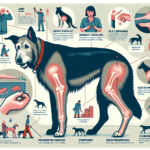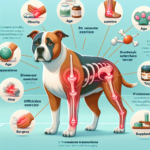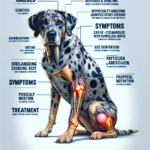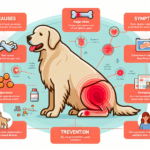Irish Wolfhound Joint Pain: Causes, Symptoms, Prevention, and Treatment

Introduction
The Irish Wolfhound is a majestic and ancient breed, known for its towering height and gentle demeanor. Originating from Ireland, these dogs were historically used for hunting wolves and large game, which is reflected in their name. With a history dating back to antiquity, the Irish Wolfhound has been a symbol of nobility and strength. Characterized by their long legs, deep chest, and wiry coat, these dogs are not only impressive in stature but also in their affectionate and loyal nature.
Despite their many admirable qualities, Irish Wolfhounds are prone to several health issues, one of the most significant being joint pain. This can manifest in various forms, such as hip dysplasia, arthritis, and elbow dysplasia. Given their large size and rapid growth rate, maintaining joint health is crucial for the overall well-being of this breed.
Joint health is particularly important for Irish Wolfhounds due to their size and the physical demands placed on their bodies. Poor joint health can severely impact their quality of life, leading to pain, reduced mobility, and even a shortened lifespan. Therefore, understanding the causes, symptoms, prevention, and treatment of joint pain in Irish Wolfhounds is essential for any responsible owner.
Breed-Specific Joint Pain Risks
Genetic Predisposition
Irish Wolfhounds have a genetic predisposition to several joint-related issues. Hip dysplasia, a condition where the hip joint does not fit properly into the hip socket, is particularly common. This can lead to arthritis and chronic pain over time. Elbow dysplasia, another hereditary condition, affects the elbow joint and can cause similar issues. These genetic factors make it crucial for breeders to screen for these conditions to reduce their prevalence in future generations.
Age-Related Risks
As Irish Wolfhounds age, the risk of developing joint pain increases. The breed’s rapid growth rate during puppyhood can put additional stress on developing joints, making them more susceptible to issues later in life. Typically, signs of joint pain may start to appear as early as middle age, around 5 to 7 years old. However, some dogs may show symptoms earlier or later, depending on their overall health and lifestyle.
Activity Level and Joint Stress
Irish Wolfhounds are generally not as high-energy as some other breeds, but they do require regular exercise to maintain their health. However, excessive or inappropriate exercise can exacerbate joint issues. Activities that involve a lot of jumping or running on hard surfaces can put undue stress on their joints. Therefore, it’s essential to balance their need for exercise with the need to protect their joints.
Common Symptoms of Joint Pain in Irish Wolfhounds
General Symptoms
Owners should be vigilant for common symptoms of joint pain, which include:
- Limping or favoring one leg
- Stiffness, especially after resting
- Reluctance to move, jump, or climb stairs
- Swelling around the joints
- Visible discomfort or pain when touched
- Decreased activity level
Breed-Specific Symptoms
In Irish Wolfhounds, symptoms of joint pain may be more pronounced due to their size. For instance, you might notice a more significant change in their gait or a more noticeable reluctance to engage in activities they previously enjoyed. Given their size, even minor joint issues can have a more substantial impact on their mobility and overall quality of life.
When to Consult a Vet
If you observe any of the above symptoms, it’s crucial to consult a veterinarian promptly. Early diagnosis and treatment can significantly improve the prognosis and quality of life for your Irish Wolfhound. Delaying a vet visit can lead to worsening symptoms and more severe joint damage.
Preventive Measures for Joint Health
Exercise Recommendations
Regular, moderate exercise is essential for maintaining joint health in Irish Wolfhounds. Activities like walking, swimming, and gentle play are ideal. Avoid high-impact activities such as jumping or running on hard surfaces. Consistent, low-impact exercise helps maintain muscle mass and joint flexibility without putting excessive stress on the joints.
Dietary Suggestions
A balanced diet rich in essential nutrients can support joint health. Foods high in omega-3 fatty acids, glucosamine, and chondroitin are particularly beneficial. These nutrients help reduce inflammation and support cartilage health. Consider incorporating supplements specifically designed for joint health, but always consult your vet before making any dietary changes.
Weight Management
Maintaining a healthy weight is crucial for reducing joint stress. Excess weight can exacerbate joint issues and lead to more severe pain and mobility problems. Regularly monitor your dog’s weight and adjust their diet and exercise routine as needed to keep them at an optimal weight.
Early Screening and Monitoring
Regular veterinary check-ups are essential for early detection of joint issues. Screening tests such as X-rays can help identify problems before they become severe. Early intervention can significantly improve outcomes and help manage symptoms more effectively.
Treatment Options for Joint Pain
Non-Surgical Treatments
Non-surgical treatments are often the first line of defense against joint pain. These may include:
- Medications: Anti-inflammatory drugs and pain relievers can help manage symptoms.
- Physical Therapy: Exercises and treatments designed to improve joint function and reduce pain.
- Lifestyle Adjustments: Modifying exercise routines and making changes to the home environment to reduce joint stress.
Surgical Options
In severe cases, surgical intervention may be necessary. Common surgical options include:
- Hip Replacement: Replacing the damaged hip joint with an artificial one.
- Arthroscopy: A minimally invasive procedure to clean out the joint.
- Joint Fusion: Fusing the joint to reduce pain and improve stability.
Surgery should always be considered a last resort, and the decision should be made in consultation with a veterinary specialist.
Alternative Therapies
Alternative treatments can also be beneficial for managing joint pain. These may include:
- Acupuncture: Can help reduce pain and improve joint function.
- Hydrotherapy: Water-based exercises that reduce joint stress while improving mobility.
- Massage: Helps improve circulation and reduce muscle tension around the joints.
Lifestyle and Management Tips
Daily Care Routine
A consistent daily care routine can help manage joint pain effectively. This might include:
- Regular, low-impact exercise
- A balanced diet with joint-supporting nutrients
- Administering any prescribed medications or supplements
- Regular vet check-ups for monitoring joint health
Modifying the Home Environment
Making your home more comfortable for a dog with joint pain can significantly improve their quality of life. Consider the following modifications:
- Installing ramps to help them navigate stairs
- Providing orthopedic beds for better joint support
- Using non-slip mats to prevent falls
Long-Term Management
Long-term management of joint pain involves a combination of regular veterinary care, appropriate exercise, a balanced diet, and a supportive home environment. Consistency is key to keeping your Irish Wolfhound active and happy despite joint pain.
FAQs About Irish Wolfhounds and Joint Pain
What are the early signs of joint pain in Irish Wolfhounds?
Early signs include limping, stiffness, reluctance to move, and visible discomfort when touched. If you notice any of these symptoms, consult your vet promptly.
Can joint pain in Irish Wolfhounds be prevented?
While you can’t entirely prevent genetic conditions, you can take steps to minimize the risk. These include regular exercise, a balanced diet, maintaining a healthy weight, and early screening for joint issues.
Are there specific foods that can help with joint health?
Yes, foods rich in omega-3 fatty acids, glucosamine, and chondroitin can support joint health. Consult your vet for dietary recommendations tailored to your dog’s needs.
When should I consider surgery for my dog’s joint pain?
Surgery should be considered when non-surgical treatments are no longer effective, and your dog’s quality of life is significantly impacted. Always consult with a veterinary specialist before making this decision.
Conclusion
Joint pain is a significant concern for Irish Wolfhounds, given their size and genetic predispositions. By understanding the causes, symptoms, preventive measures, and treatment options, you can help ensure your dog maintains a high quality of life. Regular veterinary care, a balanced diet, appropriate exercise, and a supportive home environment are crucial for managing joint health. Always consult your veterinarian for personalized advice and treatment plans to keep your Irish Wolfhound happy and healthy.




